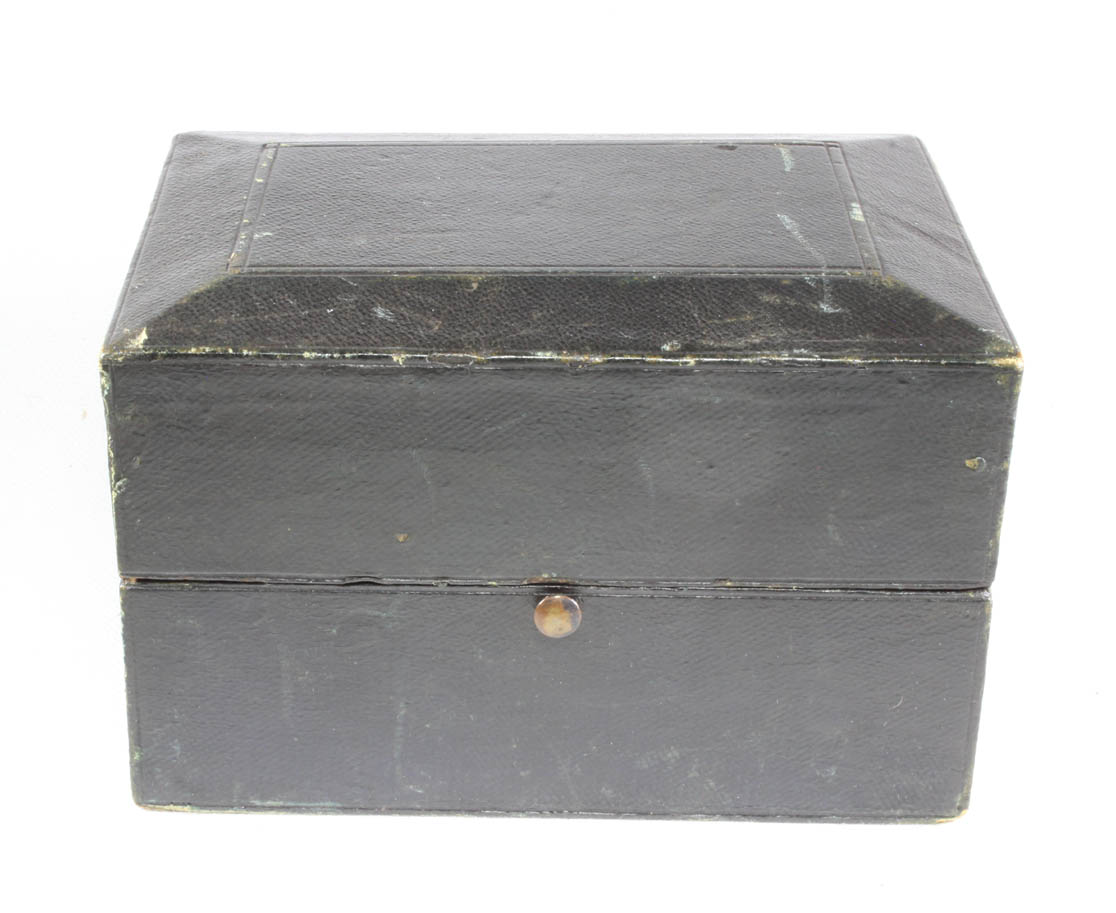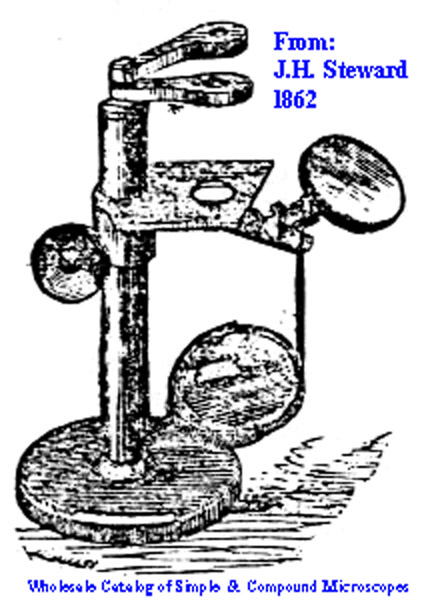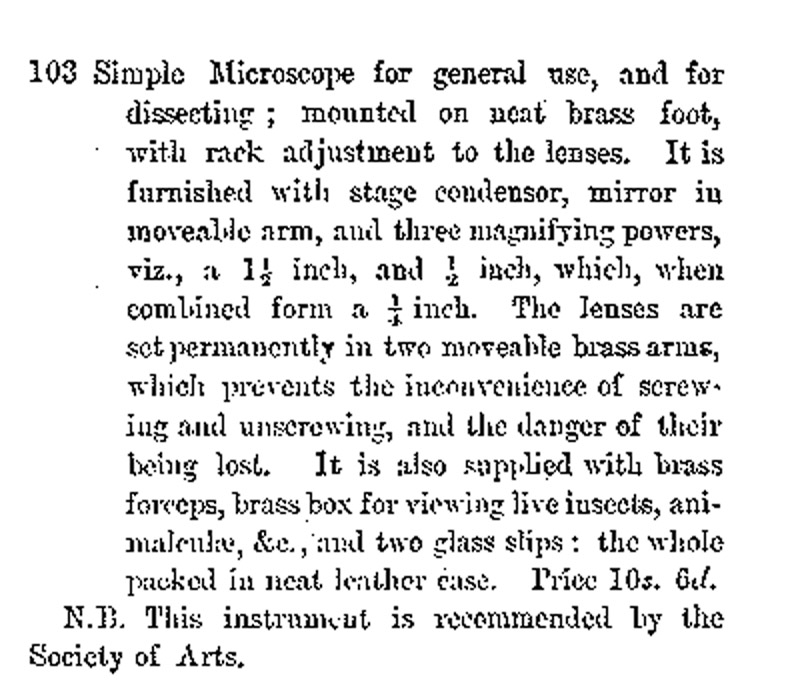MICROSCOPE-ANTIQUES.COM © 2013-16.
MODEL: ?
DATE: c. 1865
MAKER: SOLD BY J.H. STEWARD
UNSIGNED
SERIAL NUMBER: None
COUNTRY OF ORIGIN: SOLD IN ENGLAND BUT LIKELY MADE IN FRANCE.
DESCRIPTION:
 This botanical microscope arises from a circular brass foot which supports the round pillar. The mirror is white plaster on one side, mirrored on the other. There is rack and pinion focusing via a single knob acting on the inner pillar. There are two swinging lenses at the top of the inner pillar which can be used singly or in combination. The stage has a damascened finish. An arm attaches to the underside of the stage, stowed under the stage until needed. It then swings out to support a bullseye condenser. A small livebox and a single ivory slider were included. The original blue velour-lined fitted case is covered in thin black leather. This microscope is identical to number 68 in Singular Beauty although this example has a different, but original, fitted case.
This botanical microscope arises from a circular brass foot which supports the round pillar. The mirror is white plaster on one side, mirrored on the other. There is rack and pinion focusing via a single knob acting on the inner pillar. There are two swinging lenses at the top of the inner pillar which can be used singly or in combination. The stage has a damascened finish. An arm attaches to the underside of the stage, stowed under the stage until needed. It then swings out to support a bullseye condenser. A small livebox and a single ivory slider were included. The original blue velour-lined fitted case is covered in thin black leather. This microscope is identical to number 68 in Singular Beauty although this example has a different, but original, fitted case.
HISTORY OF BOTANICAL MICROSCOPES

 As shown in the catalog illustration, this exact model was offered by J.H. Steward in their 1862 wholesale catalog as a 'Simple Microscope for General Use and for Dissecting.'
'Botanical Pocket' microscopes were very popular in the 18th and 19th centuries. They ranged from simple hand-held magnifiers to portable stands like this one. Fitting into a small case, this instrument would still qualify as a 'Pocket Microscope.'
There are many similar such 'botanical' microscopes in this collection. This example bears some resemblance to the earlier
'Improved Botanical' or 'Universal Pocket' microscope by Adams and then W & S Jones, but with the more advanced rack and pinion focusing instead of a push-pull or Hevelius screw mechanism which the Jones type had. The Jones' succeeded Adams who first described his version about 1787 in his Essays on the Microscope. Dr Withering, the discoverer of digitalis, also developed a type of botanical microscope first mentioned about 1776. Three versions of the Withering Botanical Microsope are shown on this Web site. He also was known for a self-erecting type which became upright when the lid of its box was opened. The English also made more and more complex small botanical instruments, some of which were quite well made. Many of these are also shown on this web site.
As shown in the catalog illustration, this exact model was offered by J.H. Steward in their 1862 wholesale catalog as a 'Simple Microscope for General Use and for Dissecting.'
'Botanical Pocket' microscopes were very popular in the 18th and 19th centuries. They ranged from simple hand-held magnifiers to portable stands like this one. Fitting into a small case, this instrument would still qualify as a 'Pocket Microscope.'
There are many similar such 'botanical' microscopes in this collection. This example bears some resemblance to the earlier
'Improved Botanical' or 'Universal Pocket' microscope by Adams and then W & S Jones, but with the more advanced rack and pinion focusing instead of a push-pull or Hevelius screw mechanism which the Jones type had. The Jones' succeeded Adams who first described his version about 1787 in his Essays on the Microscope. Dr Withering, the discoverer of digitalis, also developed a type of botanical microscope first mentioned about 1776. Three versions of the Withering Botanical Microsope are shown on this Web site. He also was known for a self-erecting type which became upright when the lid of its box was opened. The English also made more and more complex small botanical instruments, some of which were quite well made. Many of these are also shown on this web site.
The author is indebted to Dr Joseph Zeligs for the catalog entry contained herein.
 This botanical microscope arises from a circular brass foot which supports the round pillar. The mirror is white plaster on one side, mirrored on the other. There is rack and pinion focusing via a single knob acting on the inner pillar. There are two swinging lenses at the top of the inner pillar which can be used singly or in combination. The stage has a damascened finish. An arm attaches to the underside of the stage, stowed under the stage until needed. It then swings out to support a bullseye condenser. A small livebox and a single ivory slider were included. The original blue velour-lined fitted case is covered in thin black leather. This microscope is identical to number 68 in Singular Beauty although this example has a different, but original, fitted case.
This botanical microscope arises from a circular brass foot which supports the round pillar. The mirror is white plaster on one side, mirrored on the other. There is rack and pinion focusing via a single knob acting on the inner pillar. There are two swinging lenses at the top of the inner pillar which can be used singly or in combination. The stage has a damascened finish. An arm attaches to the underside of the stage, stowed under the stage until needed. It then swings out to support a bullseye condenser. A small livebox and a single ivory slider were included. The original blue velour-lined fitted case is covered in thin black leather. This microscope is identical to number 68 in Singular Beauty although this example has a different, but original, fitted case.

 As shown in the catalog illustration, this exact model was offered by J.H. Steward in their 1862 wholesale catalog as a 'Simple Microscope for General Use and for Dissecting.'
'Botanical Pocket' microscopes were very popular in the 18th and 19th centuries. They ranged from simple hand-held magnifiers to portable stands like this one. Fitting into a small case, this instrument would still qualify as a 'Pocket Microscope.'
There are many similar such 'botanical' microscopes in this collection. This example bears some resemblance to the earlier
'Improved Botanical' or 'Universal Pocket' microscope by Adams and then W & S Jones, but with the more advanced rack and pinion focusing instead of a push-pull or Hevelius screw mechanism which the Jones type had. The Jones' succeeded Adams who first described his version about 1787 in his Essays on the Microscope. Dr Withering, the discoverer of digitalis, also developed a type of botanical microscope first mentioned about 1776. Three versions of the Withering Botanical Microsope are shown on this Web site. He also was known for a self-erecting type which became upright when the lid of its box was opened. The English also made more and more complex small botanical instruments, some of which were quite well made. Many of these are also shown on this web site.
As shown in the catalog illustration, this exact model was offered by J.H. Steward in their 1862 wholesale catalog as a 'Simple Microscope for General Use and for Dissecting.'
'Botanical Pocket' microscopes were very popular in the 18th and 19th centuries. They ranged from simple hand-held magnifiers to portable stands like this one. Fitting into a small case, this instrument would still qualify as a 'Pocket Microscope.'
There are many similar such 'botanical' microscopes in this collection. This example bears some resemblance to the earlier
'Improved Botanical' or 'Universal Pocket' microscope by Adams and then W & S Jones, but with the more advanced rack and pinion focusing instead of a push-pull or Hevelius screw mechanism which the Jones type had. The Jones' succeeded Adams who first described his version about 1787 in his Essays on the Microscope. Dr Withering, the discoverer of digitalis, also developed a type of botanical microscope first mentioned about 1776. Three versions of the Withering Botanical Microsope are shown on this Web site. He also was known for a self-erecting type which became upright when the lid of its box was opened. The English also made more and more complex small botanical instruments, some of which were quite well made. Many of these are also shown on this web site.